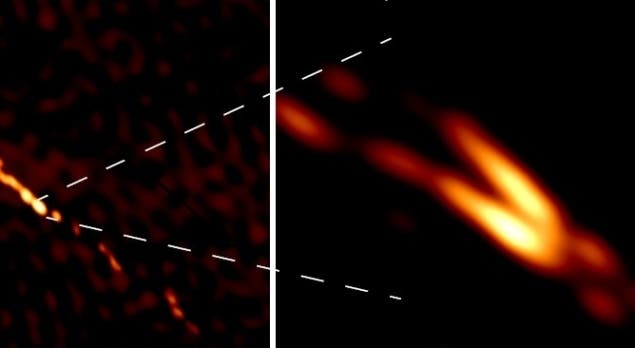
In 2019, astronomers with the Event Horizon Telescope (EHT) project made history after they imaged the shadow of a black hole for the very first time. The picture showed a dark circle surrounded by swirling, bright features resembling a ring of fire, just like Einstein’s general relativity predicted. Now, researchers affiliated with the EHT have done it again, this time for a much smaller black hole. The findings suggest that black holes behave similarly over a wide range of masses.
General relativity aces another test
The first historic direct image of a black hole revealed the event horizon of the supermassive black hole that sits at the heart of Messier 87, a distant galaxy located about 53.5 million light-years away. This is a huge black hole even by supermassive standards.
M87’s supermassive black hole packs the mass of several billion suns into a surprisingly tiny volume. It’s about 1,000 times more massive than the Milky Way’s black hole, Sagittarius A*.
Black holes are the dark remnants of collapsed stars whose gravity is so intense that nothing, not even light, can escape. Because light cannot escape the gravitational pull of a black hole, it is virtually impossible to image or photograph one. However, matter and energy aggregate around the edge of a black hole, a ring-shaped feature known as the event horizon — and this can be imaged because some light manages to escape and reach us.
For M87, due to its behemoth mass, the jets of matter around the event horizon came to resemble a ring of light or an accretion disk.
Now, a team of astronomers led by Michael Janssen of the Max-Planck-Institut für Radioastronomie in Bonn, Germany, has made a new radio observation of the jet of plasma emitted from another supermassive black hole.
The researchers directed the Event Horizon Telescope — a combination of eight radio telescopes located all around the world that form a planetary-scale radio telescope — towards Centaurus A, the nearest active galaxy to Earth with a strong hot plasma jet that emits lots of radio emissions. It lies about 12 million light-years away in the southern constellation of Centaurus.
“It [Centaurus radio waves] is gigantic – 1.5 million light-years across. If you had radio eyes, you would see a structure that covers 200 times that of the full moon,” said Heino Falcke, professor of Astroparticle Physics and Radio Astronomy at Radboud University Nijmegen in the Netherlands and Janssen’s Ph.D. advisor.
“How is this possible? We think black holes are the source of all this. So, we wanted to see how this is happening,” Falcke told ZME Science.
Centaurus A had been imaged by radio observatories since the 1940s. Due to its powerful radio waves, it has always been an easy target for astronomers. However, this time Centaurus A’s black hole has been imagined with the powerful EHT at ten times higher resolution than previous observations.
“With the EHT we see the innermost region of jets and we can see their structure. That is very difficult and rare,” Falcke said.
“What we found was that Cen A looks remarkably like M87. Like a giant pair of scissors- telling us that these jets are hollow. Probably due to the action of magnetic fields ejecting the plasma.”
However, unlike M87, the researchers didn’t see a ring — and that’s good news!
As expected, the EHT observation could only see a faint wisp of plasma jet as it emerged from the event horizon. That’s because Centaurus A* is much smaller than M87*, about 100 times smaller. Due to its more modest size “we can’t see entirely down to the black hole yet, but we see how the plasma jet emerges and is collimated,” Falcke said.
These observations, which were performed with a resolution down to a scale of less than a light-day, are in agreement with general relativity. They also fill in the blanks and dispel many uncertainties scientists had about black hole behavior at different scales, suggesting that supermassive black holes are just like any other black hole, only at a grander scale.
It is very likely that Sagittarius A*, whose mass is between Centaurus A* and M87*, also behaves the same. Of course, this remains to be seen. The team of researchers is currently working on EHT observations of the Milky Way’s supermassive black hole and hopes to get something out by the end of the year.
Of course, that’s easier said than done. Black hole observations are a lot more demanding than meets the eye — and sometimes they can be outright dangerous. Janssen, the lead author of the new study, was working with a radio telescope in Mexico at 4,500 meters altitude when, one day in 2018, he was confronted by six heavily armed men in a black truck.
“We canceled the experiment at this point, but still got some data. All returned safely, but shocked,” said Falcke, who wrote more about such stories and his work imaging black holes in a best-selling book called Light in the Darkness.
The Centaurus A* observations were described in the journal Nature Astronomy.


